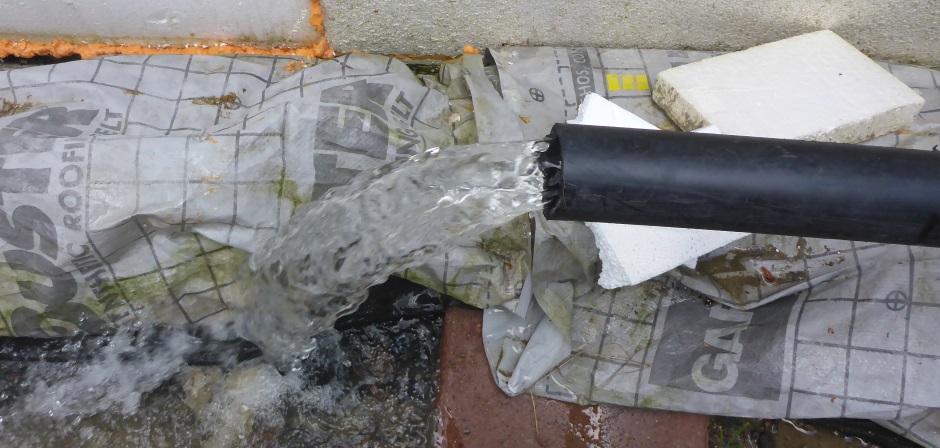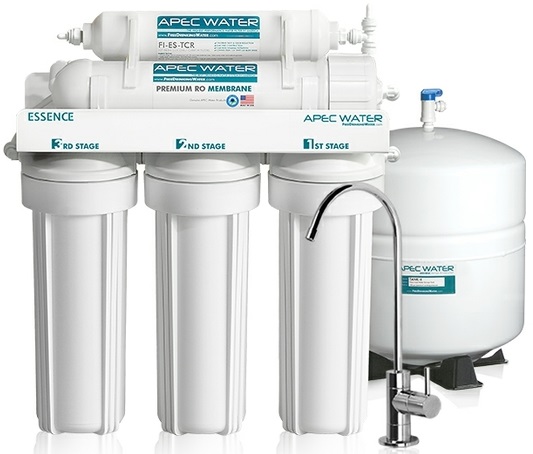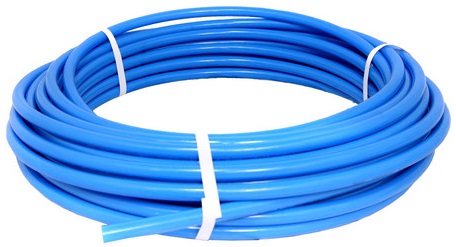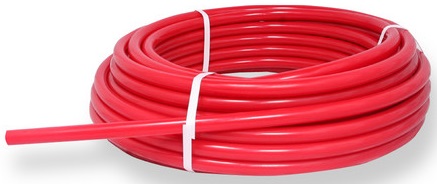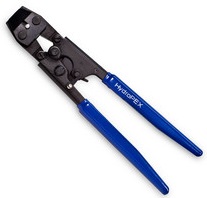Home Site Map - Techniques - Plumbing -
Plumbing Water Feed
![]() Using PEX to get potable water and hot water to your faucets and other
fixtures.
Using PEX to get potable water and hot water to your faucets and other
fixtures.
Water line to house
This is the thick walled plastic pipe (designed for direct burial in soil) that comes from the wellhouse to the house. It needs to be a nice big diameter to achieve good water flow. I use 2" diameter pipe.
Main water shutoff
Having a main water shutoff as it enters the house is required by code.
It is a 2" diameter underground pipe to the house which then connects to a 2" PVC pipe as it goes inside the house.
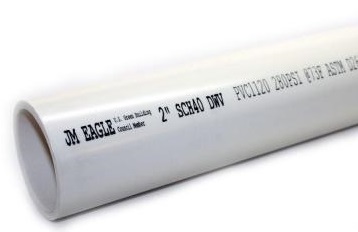 Details here .
Details here .
WA State code says: "604.14 Plastic Pipe Termination. Plastic water service piping <ie PVC which is approved for the water line to the house> may terminate within a building, provided the connection to the potable water distribution system shall be made as near as is practical to the point of entry and shall be accessible. Barbed insert fittings with hose clamps are prohibited as a transition fitting within the building. ".
Use a 2" PVC shutoff tap.
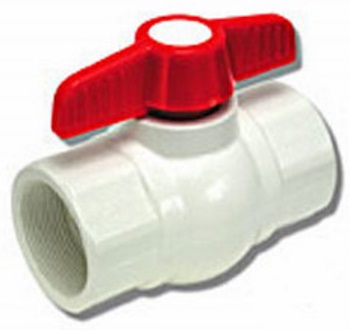 Details here .
Details here .
PVC vs CPVC
It is worth noting the difference between PVC and CPVC. PVC is the regular white pipe and should be used with PVC fittings. CPVC can handle hot water better than PVC, but PVC is fine up to 140 degrees F. The water supply to the house is cold water and as such it is best to use PVC pipe and fittings.
It is ok to use regular white PVC pipe and fittings for cold potable drinking water.
If you are handling hot water then you need to use CPVC pipe and fittings.
For some unknown reason PVC is not on the list of approved piping for potable water within a building (but CPVC is approved).
For potable water you need to transition to PEX as soon as practical within the building.
For the fire sprinkler system you need to transition to CPVC (preferably Orange) as soon as practical within the building. <Check with Fire Inspector whether pipe needs to be Orange CPVC in WA State> http://www.vikingcorp.com/blazemaster-cpvc-pipe
NSF certified
NSF is a Public Health and Safety Organization. Amongst other things, they certify that products are safe for potable water. It is always good to choose products that are NSF certified when plumbing potable water. There is useful info at http://www.milwaukeevalve.com/data/pdf/NSFandMV.pdf .
Water softener
I don't use a water softener as I don't have hard water. If I did have one it would go after the whole house water shutoff. Softened water is nice to bathe in and good for keeping the shower and tub clean. Even if not installing a water softener it is good to provide space for it and a length of 2" PVC pipe that can be cut to add it later.
Toilet flushing water distribution
This is a dead-headed feed that goes past all the toilets in the house in a daisy chain with taps off to the different toilets. The pipe is 1/2" PEX.
A deliberate pipe disconnect/reconnect changeover is provided so the toilets can be switched between potable water or pressurized rain water. A check valve or a different pipe solution should be provided so no water from dirty pipes ever flows back into the potable water system if rain water has ever been used.
Fire sprinkler water distribution
2" Orange CPVC
Cold water distribution (unfiltered)
The term "Unfiltered" refers to water than has only been through the single whole house water filter rather than through the additional filter system.
It is good to avoid water going stale in the cold water pipes. This is a particular problem in a large house with any faucets that are rarely used. Rather than using a central manifold with pipes star-ed out to each faucet, it is better to use a loop that goes around the house past each faucet. The source water is applied to both ends of the PEX loop and it practice the water will run in whatever direction provides the least resistance. It is good to arrange for a high usage faucet to be at the farthest point in the loop.
Fixtures such as baths, showers, washing machines, etc are best fed with unfiltered water. This is partly because there is no point in wearing out a filter with all this water and partly because you want the maximum possible flow.
Water distribution to toilets
This is done with 1/2" PEX. It is the same 2" pipe that feeds the unfiltered cold water manifolds on the upper floors.
This is done with 1/2" PEX.
Cold water to hot water heater
I use 3/4" PEX to the water heater. There is some question about using PEX to connect to water heaters, but I think it's fine.
Water filter
A water filter is worthwhile, but I'm not convinced it's worth spending the money on a mega expensive one. I used a $50 water filter.
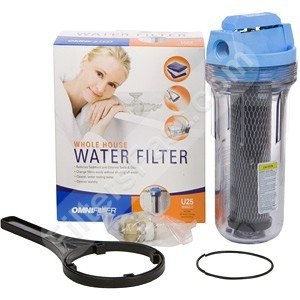 Details here .
Details here .
For really clean water it is good to put a Reverse Osmosis Water Filter under the kitchen sink, particularly as these are now under $200. In practice you only really need Reverse Osmosis if you are using city water in an area where the pipes are old.
Feed the RO filter into a dispenser that can do both ice cold and hot water...
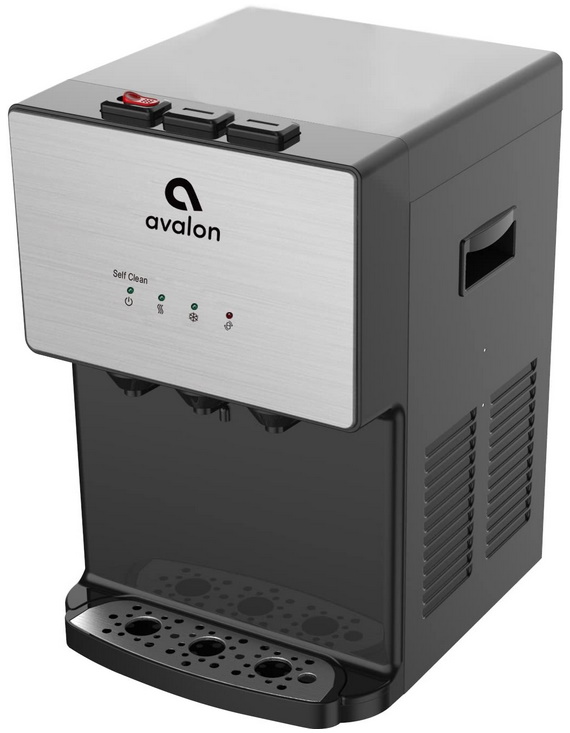
https://smile.amazon.com/gp/product/B079VHRG56/ref=ox_sc_act_title_1?smid=ATVPDKIKX0DER&th=1 $282.56
Whole house Filtered Cold Water
This manifold provides the feeds of filtered water to faucets on all the floors that want drinking water. There is no point in using big diameter pipe as the input to this manifold because the flow rate is already limited by the water filter. Using 1/4" John Guest piping is fine. Use a loop of pipe fed from both ends so there is no danger of stale water.
PEX for cold and hot water
Pipe
For potable (ie drinking) water you need PEX tubing that DOES NOT have an oxygen barrier. The type with an oxygen barrier is just for use in radiant heating systems where the heating system uses cast iron parts and you want to avoid rust.
The best brand is AquaPEX. The best type is PEX-a. AquaPEX is the only PEX-a material available for drinking water. Details are here .
Connection system
There are various connector types that can be used with PEX tubing, but here is my recommendation. Use the crimp connectors/fittings, but use them with stainless steel clamp rings (rather than copper crimp rings). Crimp style fittings are the most common and affordable type of PEX fittings and can be found in most home centers and online stores. It will cost you about $40 for a clamp tool (but this is less than a crimp tool).
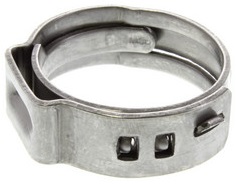
The clamping system is just like the crimping system but has the following advantages:
Tool fits into tighter spaces
Less accuracy is required
The tool is slightly cheaper
Less prone to operator error
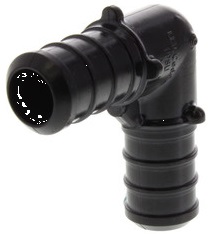 Details here
.
Details here
.
I prefer to use lead-free brass connectors. If you buy any brass fittings then make sure they are zero-lead.
Lots of extra good info on PEX is available at http://www.pexsupply.com/resources .
Little known handling characteristics of PEX
All PEX tubing not totally concealed in the wall cavity MUST BE sleeved with a UV light barrier sleeve.
PEX may not be connected directly to a water heater (although in practice it is likely to be fine for an electrical water heater)..
PEX tubing may not be run within 6" horizontal or 12" vertical of a water heater or furnace flue pipe, a heating unit or a fluorescent or incandescent lighting fixture.
Horizontal runs of PEX tubing must be supported at not more than 32" increments..
On a horizontal run, PEX support hangers must not restrict movement of the tubing.
On a vertical run, PEX must be supported at each floor plus halfway between floors.
When running PEX, you must allow 1" per 100 linear feet for each 10deg.F change in working temperature differential.
The minimum turning radius of PEX may not be less than 5x the tubing diameter (some local codes restrict it to 8 or 10 times the diameter).
When bending PEX tubing it may not be bent contrary to the natural curl of the tubing from the original roll.
PEX tubing must be stored and transported in a closed shipping container and should only be opened immediately before use.
PEX tubing must be cut with a plastic tubing cutter. If a hacksaw is used, the tubing must be supported in a miter box while cutting and you will need to flush-out the swarf.
All fittings used on PEX tubing must be specifically listed in the manufacturers data sheet as being acceptable for that particular brand of PEX tubing, and the manufacturers data sheet must be on the jobsite during installation.
When installing PEX tubing it may not be dragged over bare earth or a concrete surface.
Water heaters
Avoid anything that has cast iron because it will rust if you use the water for radiant heating and you use potable water PEX tubing.
Avoid a tankless water heater (unless you live alone in a one room apartment that has poor insulation and you are out all day). A water heater with a well insulated tank will give you better efficiency and the small amount of heat that does escape will be within the thermal envelope of the house so will help warm the house.
The latest building code requires the use of a heat pump water heater because of its greater efficiency.
In the case of a resistance water heater, site the boiler where the small amount of escaping heat can be the most beneficial. A good place is in an airing cupboard for clothes on the bedroom floor, although in practice it is more practical to put it in the basement.
Water heaters with tanks come in a full range of sizes from a few gallons (the one pictured is 6 gallons and is not a heat pump type) to many 10s of gallons.
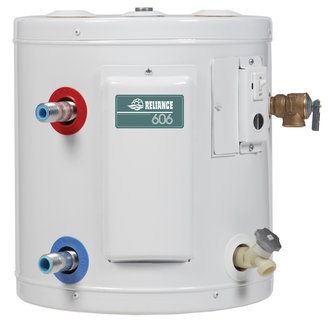
Water leaks and floor drains
Safe pans are required by code under water tanks six gallons in capacity or more when elevated above any occupied space, minimum drain size is 1-1/4”. (A safe pan or safe waste system is not required by code under washing machines.) In my case the water heater is in the basement, ie not above an occupied living space, so a water catching pan is not required by code.
A safe pan under a piece of equipment is for emergency purposes only. When not an emergency it will always be dry (and so a trap would be dry). The drain from the pan must be tied indirectly (via an air gap) to an active fixture like a utility sink.
Under a water heater you do ideally want to have a mechanism for catching water if it leaks. You don't want a floor drain in the basement slab so you need another mechanism.
Hot water distribution
I use a ring of 3/4" red PEX and a recirculation pump to that all fixtures get instant hot water.
Hot water pipes inside the house should ideally be insulated so hot stays hot and you don't waste energy (in summer).
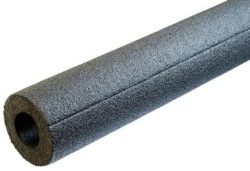 Details here
.
Details here
.




